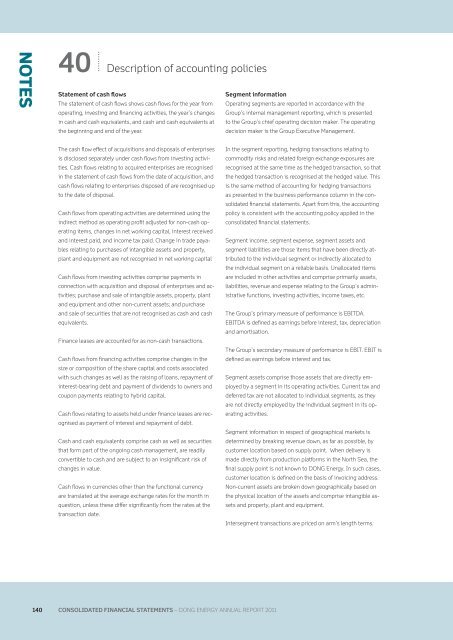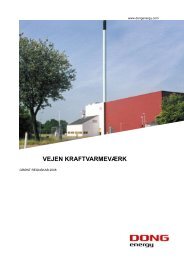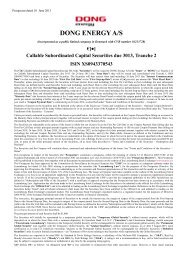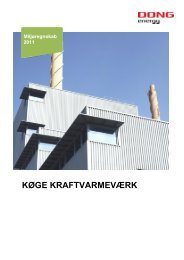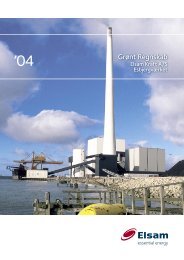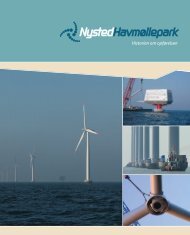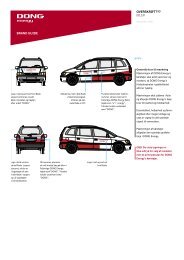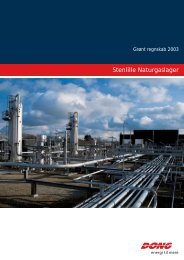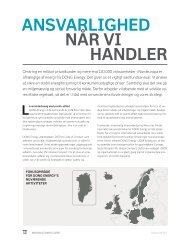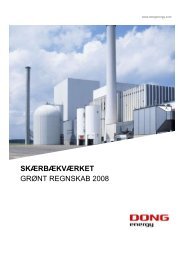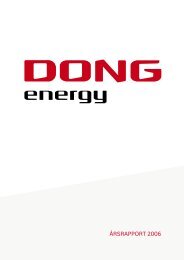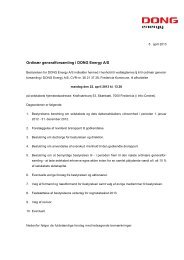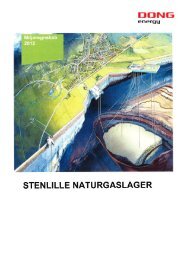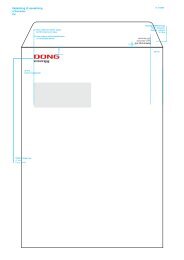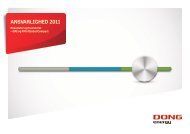ANNUAL REPORT 2011 - DONG Energy
ANNUAL REPORT 2011 - DONG Energy
ANNUAL REPORT 2011 - DONG Energy
Create successful ePaper yourself
Turn your PDF publications into a flip-book with our unique Google optimized e-Paper software.
notes<br />
40 Description of accounting policies<br />
statement of cash flows<br />
The statement of cash flows shows cash flows for the year from<br />
operating, investing and financing activities, the year’s changes<br />
in cash and cash equivalents, and cash and cash equivalents at<br />
the beginning and end of the year.<br />
The cash flow effect of acquisitions and disposals of enterprises<br />
is disclosed separately under cash flows from investing activities.<br />
Cash flows relating to acquired enterprises are recognised<br />
in the statement of cash flows from the date of acquisition, and<br />
cash flows relating to enterprises disposed of are recognised up<br />
to the date of disposal.<br />
Cash flows from operating activities are determined using the<br />
indirect method as operating profit adjusted for non-cash operating<br />
items, changes in net working capital, interest received<br />
and interest paid, and income tax paid. Change in trade payables<br />
relating to purchases of intangible assets and property,<br />
plant and equipment are not recognised in net working capital<br />
Cash flows from investing activities comprise payments in<br />
connection with acquisition and disposal of enterprises and activities;<br />
purchase and sale of intangible assets, property, plant<br />
and equipment and other non-current assets; and purchase<br />
and sale of securities that are not recognised as cash and cash<br />
equivalents.<br />
Finance leases are accounted for as non-cash transactions.<br />
Cash flows from financing activities comprise changes in the<br />
size or composition of the share capital and costs associated<br />
with such changes as well as the raising of loans, repayment of<br />
interest-bearing debt and payment of dividends to owners and<br />
coupon payments relating to hybrid capital.<br />
Cash flows relating to assets held under finance leases are recognised<br />
as payment of interest and repayment of debt.<br />
Cash and cash equivalents comprise cash as well as securities<br />
that form part of the ongoing cash management, are readily<br />
convertible to cash and are subject to an insignificant risk of<br />
changes in value.<br />
Cash flows in currencies other than the functional currency<br />
are translated at the average exchange rates for the month in<br />
question, unless these differ significantly from the rates at the<br />
transaction date.<br />
140 COnsOliDatED finanCial statEmEnts – <strong>DONG</strong> ENERGY <strong>ANNUAL</strong> <strong>REPORT</strong> <strong>2011</strong><br />
segment information<br />
Operating segments are reported in accordance with the<br />
Group’s internal management reporting, which is presented<br />
to the Group’s chief operating decision maker. The operating<br />
decision maker is the Group Executive Management.<br />
In the segment reporting, hedging transactions relating to<br />
commodity risks and related foreign exchange exposures are<br />
recognised at the same time as the hedged transaction, so that<br />
the hedged transaction is recognised at the hedged value. This<br />
is the same method of accounting for hedging transactions<br />
as presented in the business performance column in the consolidated<br />
financial statements. Apart from this, the accounting<br />
policy is consistent with the accounting policy applied in the<br />
consolidated financial statements.<br />
Segment income, segment expense, segment assets and<br />
segment liabilities are those items that have been directly attributed<br />
to the individual segment or indirectly allocated to<br />
the individual segment on a reliable basis. Unallocated items<br />
are included in other activities and comprise primarily assets,<br />
liabilities, revenue and expense relating to the Group’s administrative<br />
functions, investing activities, income taxes, etc.<br />
The Group’s primary measure of performance is EBITDA.<br />
EBITDA is defined as earnings before interest, tax, depreciation<br />
and amortisation.<br />
The Group’s secondary measure of performance is EBIT. EBIT is<br />
defined as earnings before interest and tax.<br />
Segment assets comprise those assets that are directly employed<br />
by a segment in its operating activities. Current tax and<br />
deferred tax are not allocated to individual segments, as they<br />
are not directly employed by the individual segment in its operating<br />
activities.<br />
Segment information in respect of geographical markets is<br />
determined by breaking revenue down, as far as possible, by<br />
customer location based on supply point. When delivery is<br />
made directly from production platforms in the North Sea, the<br />
final supply point is not known to <strong>DONG</strong> <strong>Energy</strong>. In such cases,<br />
customer location is defined on the basis of invoicing address.<br />
Non-current assets are broken down geographically based on<br />
the physical location of the assets and comprise intangible assets<br />
and property, plant and equipment.<br />
Intersegment transactions are priced on arm’s length terms.


